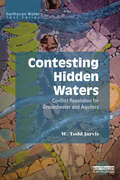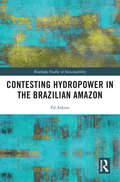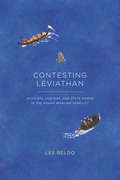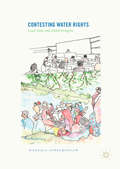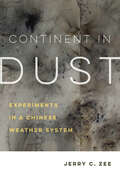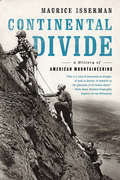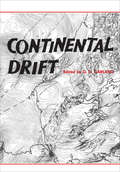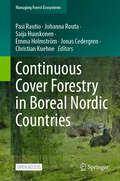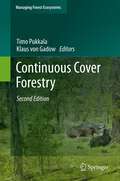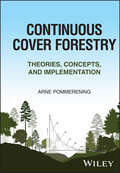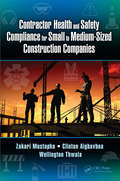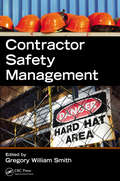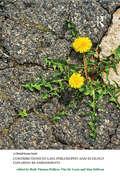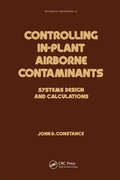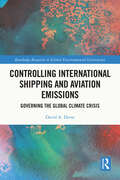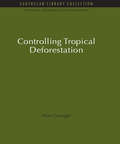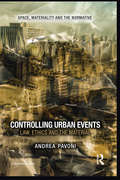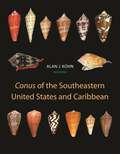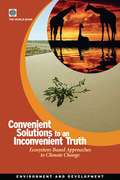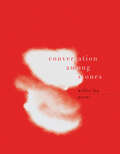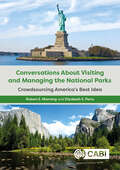- Table View
- List View
Contesting Earth's Future: Radical Ecology and Postmodernity
by Michael E. ZimmermanRadical ecology typically brings to mind media images of ecological activists standing before loggers' saws, staging anti-nuclear marches, and confronting polluters on the high seas. Yet for more than twenty years, the activities of organizations such as the Greens and Earth First! have been influenced by a diverse, less-publicized group of radical ecological philosophers. It is their work—the philosophical underpinnings of the radical ecological movement—that is the subject of Contesting Earth's Future.The book offers a much-needed, balanced appraisal of radical ecology's principles, goals, and limitations. Michael Zimmerman critically examines the movement's three major branches—deep ecology, social ecology, and ecofeminism. He also situates radical ecology within the complex cultural and political terrain of the late twentieth century, showing its relation to Martin Heidegger's anti-technological thought, 1960s counterculturalism, and contemporary theories of poststructuralism and postmodernity.An early and influential ecological thinker, Zimmerman is uniquely qualified to provide a broad overview of radical environmentalism and delineate its various schools of thought. He clearly describes their defining arguments and internecine disputes, among them the charge that deep ecology is an anti-modern, proto-fascist ideology. Reflecting both the movement's promise and its dangers, this book is essential reading for all those concerned with the worldwide ecological crisis.
Contesting Hidden Waters: Conflict Resolution for Groundwater and Aquifers (Earthscan Water Text)
by W. Todd JarvisThe world increasingly relies on groundwater resources for drinking water and the provision of food for a growing population. The utilization of aquifer systems also extends beyond freshwater supply to include other resources such as heat extraction and the storage and disposal of substances. Unlike other books about conflict resolution and negotiations over water resources, this volume is unique in focusing exclusively on conflicts over groundwater and aquifers. The author explores the specific challenges presented by these "hidden" resources, which are shown to be very different from those posed by surface water resources. Whereas surface watersheds are static, groundwater boundaries are value-laden and constantly changing during development. The book describes the various issues surrounding the governance and management of these resources and the various parties involved in conflicts and negotiations over them. Through first-hand accounts from a pracademic skilled in both process and substance as a groundwater professional and professional mediator, the book offers options for addressing the challenges and issues through a transdisciplinary approach.
Contesting Hydropower in the Brazilian Amazon (Routledge Studies in Sustainability)
by Ed AtkinsIn Contesting Hydropower in the Brazilian Amazon, Ed Atkins focuses on how local, national, and international civil society groups have resisted the Belo Monte and São Luiz do Tapajós hydroelectric projects in Brazil. In doing so, Atkins explores how contemporary opposition to hydropower projects demonstrate a form of ‘contested sustainability’ that highlights the need for sustainable energy transitions to take more into account than merely greenhouse gas emissions. The assertion that society must look to successfully transition away from fossil fuels and towards sustainable energy sources often appears assured in contemporary environmental governance. However, what is less certain is who decides which forms of energy are deemed ‘sustainable.’ Contesting Hydropower in the Brazilian Amazon explores one process in which the sustainability of a ‘green’ energy source is contested. It focuses on how civil society actors have both challenged and reconfigured dominant pro-dam assertions that present the hydropower schemes studied as renewable energy projects that contribute to sustainable development agendas. The volume also examines in detail how anti-dam actors act to render visible the political interests behind a project, whilst at the same time linking the resistance movement to wider questions of contemporary environmental politics. This interdisciplinary work will be of great interest to students and scholars of sustainable development, sustainable energy transitions, environmental justice, environmental governance, and development studies.
Contesting Leviathan: Activists, Hunters, and State Power in the Makah Whaling Conflict
by Les BeldoIn 1999, off the coast of the Pacific Northwest, the first gray whale in seven decades was killed by Makah whalers. The hunt marked the return of a centuries-old tradition and, predictably, set off a fierce political and environmental debate. Whalers from the Makah Indian Tribe and antiwhaling activists have clashed for over twenty years, with no end to this conflict in sight. In Contesting Leviathan, anthropologist Les Beldo describes the complex judicial and political climate for whale conservation in the United States, and the limits of the current framework in which whales are treated as “large fish” managed by the National Marine Fisheries Service. Emphasizing the moral dimension of the conflict between the Makah, the US government, and antiwhaling activists, Beldo brings to light the lived ethics of human-animal interaction, as well as how different groups claim to speak for the whale—the only silent party in this conflict. A timely and sensitive study of a complicated issue, this book calls into question anthropological expectations regarding who benefits from the exercise of state power in environmental conflicts, especially where indigenous groups are involved. Vividly told and rigorously argued, Contesting Leviathan will appeal to anthropologists, scholars of indigenous culture, animal activists, and any reader interested in the place of animals in contemporary life.
Contesting Water Rights: Local, State, And Global Struggles
by Mangala SubramaniamAs globalization processes and related neoliberal agendas promote privatization through state action, people’s struggles for rights to water have intensified. In this context, this book examines the role of the ambivalent state in local struggles for water, which are deeply intertwined with global forums that support and/or challenge the privatization of water resources. These local-global struggles have redefined the relationships between the state, corporations, and other social actors that impact the local politics of inequality and marginalization.
Continent in Dust: Experiments in a Chinese Weather System (Critical Environments: Nature, Science, and Politics #10)
by Jerry C. ZeeIn China, the weather has changed. Decades of reform have been shadowed by a changing meteorological normal: seasonal dust storms and spectacular episodes of air pollution have reworked physical and political relations between land and air in China and downwind. Continent in Dust offers an anthropology of strange weather, focusing on intersections among statecraft, landscape, atmosphere, and society. Traveling from state engineering programs that attempt to choreograph the movement of mobile dunes in the interior, to newly reconfigured bodies and airspaces in Beijing, and beyond, this book explores contemporary China as a weather system in the making: what would it mean to understand "the rise of China" literally, as the country itself rises into the air?
Continental Divide: A History of American Mountaineering
by Maurice IssermanThis magesterial and thrilling history argues that the story of American mountaineering is the story of America itself. In Continental Divide, Maurice Isserman tells the history of American mountaineering through four centuries of landmark climbs and first ascents. Mountains were originally seen as obstacles to civilization; over time they came to be viewed as places of redemption and renewal. The White Mountains stirred the transcendentalists; the Rockies and Sierras pulled explorers westward toward Manifest Destiny; Yosemite inspired the early environmental conservationists. Climbing began in North America as a pursuit for lone eccentrics but grew to become a mass-participation sport. Beginning with Darby Field in 1642, the first person to climb a mountain in North America, Isserman describes the exploration and first ascents of the major American mountain ranges, from the Appalachians to Alaska. He also profiles the most important American mountaineers, including such figures as John C. Frémont, John Muir, Annie Peck, Bradford Washburn, Charlie Houston, and Bob Bates, relating their exploits both at home and abroad. Isserman traces the evolving social, cultural, and political roles mountains played in shaping the country. He describes how American mountaineers forged a "brotherhood of the rope," modeled on America's unique democratic self-image that characterized climbing in the years leading up to and immediately following World War II. And he underscores the impact of the postwar "rucksack revolution," including the advances in technique and style made by pioneering "dirtbag" rock climbers. A magnificent, deeply researched history, Continental Divide tells a story of adventure and aspiration in the high peaks that makes a vivid case for the importance of mountains to American national identity.
Continental Drift
by G. D. GarlandThe possibility that the continents of the earth have undergone major changes in position during the earth's history has fascinated scholars for at least three hundred years. Recently, evidence from several scientific disciplines has shown that the possibility must be very seriously considered in any study of the surface features of the earth. The first part of this volume consists of papers given at a symposium on continental drift, held at the annual meeting of the Royal Society of Canada in Charlottetown in June 1964. They present the views of three geophysicists, a botanist, and an astronomer. In these papers, the present evidence for or against continental drift is reviewed and the authors in most cases draw their own conclusions. The reader will find that there is not unanimous agreement in favour of drift. Nearly all discussions of continental drift stress the possible separation of the Americas from Europe and Africa. Considerable work has been done on the tracing of structures, on each side of the Atlantic Ocean, which might once have been connected. Geologists and geophysicists working in the Arctic or on the eastern seaboard of Canada have an important contribution to make to this subject. The second part of this volume, therefore, consists of a group of papers, also presented at the Charlottetown meeting, which throw light on the complicated crustal structure of these regions. In any attempt to reconstruct North America as part of Europe the features described in these papers will have to be taken into account. Once again, the reader will find differences of opinion on the question of whether the evidence favours a separation of our continent from Europe. Indeed, it is because the theory of continental drift us so difficult to confirm without ambiguity by direct observation that it remains controversial but exciting.
Continuing Assistance to the National Institutes of Health on Preparation of Additional Risk Assessments for the Boston University NEIDL, Phase 3
by Committee on Continuing Assistance to the National Institutes of Health on Preparation of Additional Risk Assessments for the Boston University NEIDLIn 2003, the Boston University Medical Center (BUMC) was awarded a $128 million grant from the National Institutes of Health (NIH) to build one of two national maximum-containment laboratory facilities for pathogen research. The National Emerging Infectious Diseases Laboratories (NEIDL) are meant to support the National Institute of Allergy and Infectious Diseases' biodefense research agenda, conducting research to develop new approaches to treating, preventing, and diagnosing a variety of bacterial and viral diseases. The facility includes a biosafety level 4 (BSL-4) containment laboratory housed in a 192,000 square foot building. Although the NEIDL BSL-4 laboratory accounts for only 13 percent of the building's total space, it has been the source of virtually all of the community concern surrounding this project. The location of the facility on Albany Street in Boston's South End, which is an environmental justice community, has been controversial, and there have been numerous public meetings over the plans for the facility as well as three legal actions challenging the project. Continuing Assistance to the National Institutes of Health on Preparation of Additional Risk Assessments for the Boston University NEIDL, Phase 3, the fifth in a series of reports about the proposed facility, provides further technical input on the scope and design of any additional studies that may be needed to assess the risks associated with the siting and operation of the NEIDL. This report presents comments and questions on a "90 percent", or penultimate, draft of the revised risk assessment. According to the report, the "90 percent" draft of the risk assessment is a substantial improvement over past documents reviewed. Additionally, the report makes recommendations to improve the version that is ultimately prepared for public comment.
Continuous Cover Forestry in Boreal Nordic Countries (Managing Forest Ecosystems #45)
by Pasi Rautio Johanna Routa Saija Huuskonen Emma Holmström Jonas Cedergren Christian KuehneThis open access book compiles the latest research on continuous cover forestry in boreal forests, highlighting both the need for additional information and the exciting possibilities that this method presents. Experts in the field explore topics such as forest regeneration, genetic effects, wood production and yield, wood harvesting, forest damage agents, biodiversity, water effects, carbon cycles of forests, economics, forest planning methods, multiple uses of forests, and forest owners' attitudes. As the world faces increasing pressure to balance the multiple goals of forest management, including raw material production, carbon sequestration, biodiversity, and climate change adaptation, it is becoming clear that different forest management methods are required. Even-aged forest management is well-researched, but continuous forest management is a newer and rapidly evolving approach that is gaining popularity in boreal forests. While an overall synthesis of the subject is not yet possible, this book provides an essential foundation for understanding the current state of continuous cover forestry in boreal forests. With the new research data being accumulated all the time, this book is an invaluable resource for researchers, policymakers, and forest managers who want to stay up-to-date on this important topic.
Continuous Cover Forestry: Assessment, Analysis, Scenarios (Managing Forest Ecosystems #23)
by Klaus Von Gadow Timo PukkalaAlthough the majority of the world's forest ecosystems are dominated by uneven-sized multi-species stands, forest management practice and theory has focused on the development of plantation monocultures to maximize the supply of timber at low cost. Societal expectations are changing, however, and uneven-aged multi-species ecosystems, selectively managed as Continuous Cover Forestry (CCF), are often believed to be superior to monocultures in addressing a wide range of expectations. This book presents methods which are relevant to CCF management and planning: analysing forest structures, silvicultural and planning, economic evaluation, based on examples in Europe, Asia, Africa and North and South America.
Continuous Cover Forestry: Theories, Concepts, and Implementation
by Arne PommereningCONTINUOUS COVER FORESTRY Gain expertise in the development of healthier, more sustainable forests with this indispensable guide Continuous Cover Forestry (CCF) is an approach to forest management with over a century of history, one which applies ecological principles to the project of developing biologically diverse, structurally complex forests. Long used as the standard forest management method in Central Europe, CCF is generating renewed interest globally for its potential to develop and sustain forests that can withstand climate change impacts, maintain forest biodiversity in the face of major ecological challenges and offer better recreation experience. There is an increasingly urgent need for forest scientists and policymakers to be familiar with the toolkit provided by CCF. Continuous Cover Forestry: Theories, Concepts, and Implementation provides a thorough, up-to-date introduction to the theory and practice of CCF. Beginning with an overview of the method’s history and its foundational principles, the book provides detailed guidance for applying CCF methods to a range of ecological scenarios and forest types. The result is a clear, comprehensive portrait of this increasingly effective set of forestry tools. Continuous Cover Forestry readers will also find: Case studies throughout showing CCF at work in real-world forests Detailed discussion of topics such as forest structure, transformation, silvicultural systems, training, carbon forestry, conservation and more R code ready to take and apply Simple, adaptable models for deriving quantitative guidelines for CCF woodlands Continuous Cover Forestry is ideal for students, scholars and practitioners of forest science, forest ecology, conservation, and environmental management, as well as policymakers dealing with forestry or climate policy.
Contractor Health and Safety Compliance for Small to Medium-Sized Construction Companies
by Clinton Aigbavboa Wellington Thwala Zakari MustaphaThis book explores the formation of small and medium-sized construction company's (SME) compliance with health and safety issues in developing countries. Little has been written about the formation of SME contractors' health and safety compliance for developing countries, especially, in the sub-sahara regions where construction and infrastructure development activities have significantly increased in order to serve the development mandate of those countries. Thus, this book will provides insight into construction safety for SMEs, as well as health and safety compliance, and its policy implementation trends and development.
Contractor Safety Management
by Gregory WiIIiam SmithA Winner of the Educational Award by the World Safety OrganizationContractor safety management is often seen as nothing more than a subset of general safety management in that no special consideration needs to be given to understanding the difficulties of the contract environment. This leaves contractors endlessly juggling competing and someti
Contributions to Law, Philosophy and Ecology: Exploring Re-Embodiments (Law, Justice and Ecology)
by Ruth Thomas-Pellicer Vito De Lucia Sian SullivanContributions to Law, Philosophy and Ecology: Exploring Re-Embodiments is a preliminary contribution to the establishment of re-embodiments as a theoretical strand within legal and ecological theory, and philosophy. Re-embodiments are all those contemporary practices and processes that exceed the epistemic horizon of modernity. As such, they offer a plurality of alternative modes of theory and practice that seek to counteract the ecocidal tendencies of the Anthropocene. The collection comprises eleven contributions approaching re-embodiments from a multiplicity of fields, including legal theory, eco-philosophy, eco-feminism and anthropology. The contributions are organized into three parts: ‘Beyond Modernity’, ‘The Sacred Dimension’ and ‘The Legal Dimension’. The collection is opened by a comprehensive introduction that situates re-embodiments in theoretical context. Whilst closely bound with embodiment and new materialist theory, this book contributes a unique voice that echoes diverse political processes contemporaneous to our times. Written in an elegant and accessible language, the book will appeal to undergraduates, postgraduates and established scholars alike seeking to understand and take re-embodiments further, both politically and theoretically.
Controlling Climate Change
by Bert Metz"An unbiased and comprehensive overview, based on the findings of the IPCC (Intergovernmental Panel on Climate Change). Using no jargon, it looks at tackling and adapting to man-made climate change, and works through the often confusing potential solutions. Bert Metz is the former co-chair of the IPCC, at the center of international climate change negotiations. His insider expertise provides a cutting edge assessment of issues at the top of the political agenda. He leads the reader succinctly through ambitious mitigation scenarios, in combination with adapting our future societies to different climate conditions and the potential costs of these measures. Illustrations and extensive boxed examples motivate students to engage with this essential global debate, and questions for each chapter are available online for course instructors. Minimal technical language also makes this book valuable to anyone with an interest in action to combat climate change"--Provided by publisher.
Controlling In-Plant Airborne Contaminants: Systems Design and Calculations
by John D. ConstanceThis book is a useful reference work for practicing engineers in their evaluation and design of systems for the control of the industrial in-plant environment. It provides design criteria, useful calculations and proven techniques to control the environment in oil refineries and chemical industries.
Controlling International Shipping and Aviation Emissions: Governing the Global Climate Crisis (Routledge Research in Global Environmental Governance)
by David A. DeeseThis book assesses the extent to which two specialized UN agencies- the International Maritime Organization (IMO) in London and the International Civil Aviation Organization (ICAO) in Montreal - have been able to regulate environmental pollution in the global commons. Since the Kyoto Protocol and its tasking of these two International Organisations (IOs) in 1997 to regulate greenhouse gas emissions from the fast-growing international shipping and aviation sectors, they have struggled with the assignment even as the external pressure has mounted for them to act. David Deese examines why these two UN agencies have largely failed to execute their critical missions to date and explores the most promising emerging and feasible routes to control and reduce these emissions by other means. Drawing on a range of sources including interviews with key actors in the IMO and ICAO, as well as from industry and national governments, Deese looks at the multifaceted politics that drive these IOs and considers how this has delayed and frustrated the execution of their assigned climate mitigation missions. He also explains how the limitations of the IMO and ICAO are likely to be found to a degree in other UN specialized agencies and examines how lessons learned here will be helpful in understanding the operations of other IOs. The book will be of great interest to students and scholars of global governance and international organisations, transport and environment and climate change. It will also be a useful resource for industry and non-profit experts and public officials working in shipping and aviation regulation.
Controlling Tropical Deforestation: Controlling Tropical Deforestation (Natural Resource Management Set)
by Alan GraingerTropical rain forest is being cleared so rapidly and on such a scale that it is a major global environmental problem, threatening the survival of half of the world's plant and animal species and contributing to global climate change through the greenhouse effect. But, despite widespread concern for over twenty years, only limited progress has been made in controlling deforestation and improving forest management in the humid tropics. In this book Alan Grainger offers afresh analysis of the causes of deforestation and presents an integrated strategy for controlling it. His strategy embraces agriculture, forestry and conservation and stresses the need for changes in government policies if land use is to be made more sustainable and the underlying causes of the problem are to be addressed. Controlling Tropical Deforestation is essential reading for policy makers, agronomists, foresters, conservationists and development professionals. To general readers and students on introductory courses at schools and universities it also offers the first concise but comprehensive overview of the causes, scale and consequences of deforestation. Alan Grainger is a lecturer in geography at the University of Leeds. He is author of The Threatening Desert: Controlling Desertification, also published by Earthscan. Originally published in 1992
Controlling Urban Events: Law, Ethics and the Material
by Andrea PavoniHow does order emerge out of the multiplicity of bodies, objects, ideas and practices that constitute the urban? This book explores the relation between space, law and control in the contemporary city – and particularly in the context of urban ‘mega events’ – through a combined geographical and normative analysis. Informed by the recent spatial, affective and material ‘turns’ in the humanities and social sciences, Andrea Pavoni addresses this question by pursuing an innovative and trans-disciplinary approach, capable of accounting for the emergence of order in urban space both at the conceptual and empirical levels. Two overarching objectives are pursued. First, to account for the increasing convergence of logics, techniques and technologies of law, security and marketing into novel, potentially oppressive spatial configurations. Second, to envisage a consistent ethico-political strategy to counter this evolution, by rethinking originally and in radically spatial terms the notion of justice. Forging a sophisticated and original analysis, this book offers an analysis that will be of considerable interest to those working in critical urban geography, critical legal studies, critical event studies, surveillance and control studies.
Conus of the Southeastern United States and Caribbean
by Alan J. KohnConus is the largest genus of animals in the sea, occurring throughout the world's tropical and subtropical oceans and contributing significantly to marine biodiversity. The shells of these marine mollusks are prized for their amazing variety and extraordinary beauty. The neurotoxic venoms they produce—injected by a hollow, harpoon-like tooth into prey animals that are then paralyzed and swallowed whole—have a range of pharmaceutical applications, from painkillers to antidepressants. This beautifully illustrated book identifies 53 valid species of the southeastern United States and the Caribbean, a region that supports a diverse but taxonomically challenging group of Conus. Introductory chapters cover the evolution and phylogeny of the genus, and notes on methodology are provided. Detailed species accounts describe key identification features, taxonomy, distribution, ecology, toxicology, life history, and evolutionary relationships. The book includes more than 2,100 photos of shells on 109 splendid color plates; more than 100 additional photos, many depicting live animals in color; and 35 color distribution maps.Identifies 53 valid species—the first reassessment of western Atlantic Conus in more than seventy yearsFeatures more than 2,100 photos of shells on 109 color platesBlends the traditional shell-character approach to identification with cutting-edge shell and radular tooth morphometrics and molecular genetic analysesIncludes color images of live animals as well as color distribution maps
Convenient Solutions to an Inconvenient Truth: Ecosystem-based Approaches to Climate Change
by World BankGlobal warming and changes in climate will have severe and lasting impacts on national efforts to alleviate poverty and promote sustainable development. Some of the world's poorest countries and communities are the most vulnerable and are already suffering the consequences. Yet often these countries are rich in natural capital, ecosystems, and biodiversity that can contribute to solutions as they can to climate change. Biodiversity is the foundation and mainstay of agriculture, forests, and fisheries. Biological resources provide the raw materials for livelihoods, agriculture, medicines, trade, tourism, and industry. Forests, grasslands, freshwater, and marine and other natural ecosystems provide a range of services, often not recognized in national economic accounts but vital to human welfare: regulating water flows and water quality, flood control, pollination, decontamination, carbon sequestration, soil conservation, and nutrient and hydrological cycling. Current efforts to address climate change focus mainly on reducing emissions of greenhouse gases, mainly through cleaner energy strategies, and on attempting to reduce vulnerability of the communities at risk by improving infrastructure to meet new energy and water needs. This book sets out a compelling argument for including ecosystem-based approaches to mitigation and adaptation as a third essential pillar in national strategies to address climate change. Such ecosystem-based strategies can offer cost-effective, proven and sustainable solutions contributing to, and complementing, other national and regional adaptation strategies.
Conveniently Wed to the Greek: Conveniently Wed To The Greek His Shy Cinderella Falling For The Rebel Princess Claimed By The Wealthy Magnate
by Kandy ShepherdA marriage for the sake of her baby... When luxury hotelier Alex Mikhalis encounters the blogger who once nearly destroyed his reputation, he wants to get even. Only Adele Hudson isn't exactly as he remembers. She's pregnant and alone, and he can't stop his protective instincts kicking in! After a difficult breakup, Adele is very wary of all relationships. She has no choice but to accept the Greek tycoon's offer of a job, despite their complicated past. But his next suggestion is much more intimate: becoming his convenient wife!
Conversation Among Stones
by Willie LinAwakening to histories personal and social, Conversation Among Stones is a meditation on memory and identity. Through fields of wild grass, restless seascapes, and cities tinged with sand, Willie Lin's debut collection of poetry questions what can remain and what must be pared away in our search for truth. Conversation Among Stones speaks both to the inanimate—misremembered histories, photographs, the dead—and to the voices in our daily lives that reverberate with disagreement and confusion. Punctuated by doubt and resistant to easy transformations, these poems listen and revise. With striking restraint and simultaneous abundance, these poems attempt to reconcile the desire for answers with the necessity of not knowing.Turn by turn, this collection catalogs moments of approach, fervor, and strife and carries us into a profound quest for understanding: “And that was one conviction: / that we must be to one another / what the world is not / to us.”
Conversations About Visiting and Managing the National Parks: Crowdsourcing America’s Best Idea
by Robert Manning Dr Elizabeth E. PerryAs the popularity of the national parks grows, so do the challenges of visiting and managing them. This innovative book uses crowdsourcing - postings by park visitors on a range of social media sites - to start 100 conversations on issues associated with visiting and managing the national parks. The authors then use their experience and expertise to prepare short, plainspoken, and engaging essays that respond to the postings and complete the conversations. The book is written for park visitors, managers, and students. The authors are university professors who teach the history, philosophy, and management of national parks, conduct long-term programs of research for the National Park Service, and have spent years working and living in the national parks. This inventive, thoughtful, and inviting book addresses a wide range of national park-related issues, guides readers on how to more effectively plan and conduct their national park visits, informs park planners and managers about what visitors think about the parks, introduces the latest scientific and professional information on park management, helps prepare students for careers in park management, and enhances public appreciation and protection of the national parks. Preservation of our national parks has always required an active engagement with the public. The authors take this to a new level by responding directly to the many questions and comments posed by visitors on social media with thoughtful and informative responses. Jonathan B. Jarvis, eighteenth Director of the National Park Service

